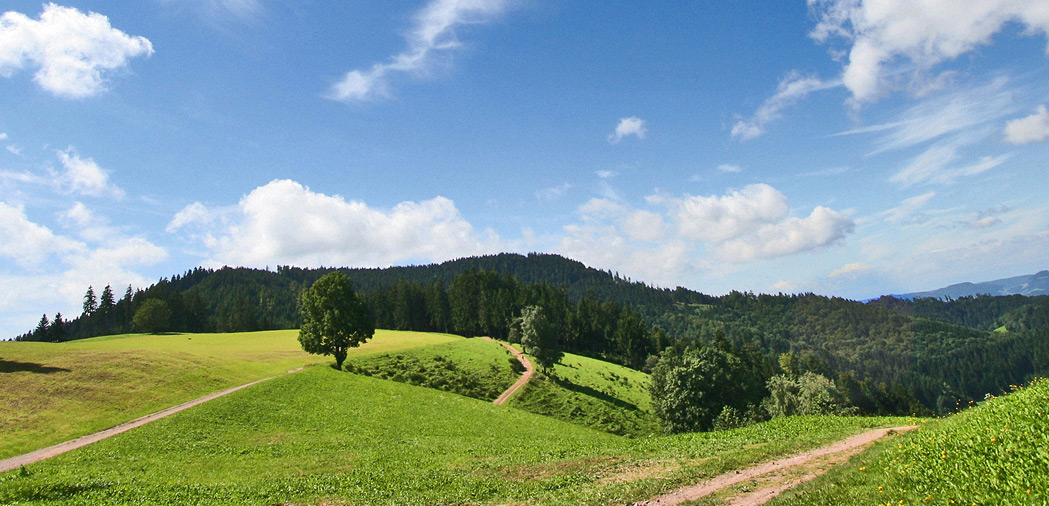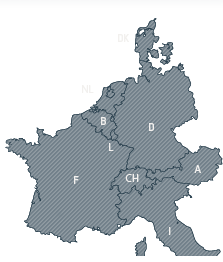Premium Hiking Trails
Criteria for the "Hiking Certificate Premium Trail"
How does a hiking experience become measurable?
With 34 criteria for an optimal hiking experience
At the suggestion of leading tourism professionals, we have developed a catalogue of criteria that allows us to determine the strengths and weaknesses of a hiking trail as objectively and precisely as possible. Since 1999, this catalogue has been improved again and again on the basis of the results of regular surveys of hikers (Profilstudien Wandern, now Hiking Monitor). Under the name "Hiking Certificate Premium Trail", this catalogue offers the possibility of comprehensively evaluating the quality of hiking trails.
For every kilometer of trail, about 200 characteristics concerning the trail format, the landscape, cultural sights, civilizational barriers, the hiking guidance system, and the macroenvironment are surveyed on the basis of 34 criteria.
Thus, in addition to purely technical conditions, a very broad spectrum of influences that make up the hiking experience is put into figures.
In this way, the diverse elements of the hiking experience can be related to each other in such a way that a guarantee of eventful experiences can be drawn for the most diverse preferences. The path inventory associated with the "German Hiking Certificate – Premium Hiking Trail" is very complex and can only be carried out by trained experts. It is only offered for trails of particularly high quality, which are to be advertised as tourist hiking trails for the respective destination and marketed at a correspondingly high cost.
Core criteria (simplified)
| Composite surface | max. 1,200 m at a stretch (when boarding attractive destinations up to an additional 300 m to max. 2,000 m per destination), max. 15% of the total trail length |
|---|---|
| Traffic safety | (e.g., passages on through roads) max. 150 m at a stretch, max. 3% of the total trail length |
| Alongside through roads | max. 1.200m at a stretch (when boarding attractive destinations up to an additional 300 m to max. 2,000 m per destination), max. 10% of the total trail length |
| Path not easily walkable | max. 500 m at a stretch, max. 5% of the total trail length |
| User-friendly markings | visual marker obligatory, if the direction changes there should be a reassuring marker on the trail within sight. reliable locating of the hiking trail along the entire route |
| Changes in landscape | at least two distinctive changes of environment within a stretch of 6 km |
| Intensively used environment | max. 1,000 m at a stretch (when boarding attractive destinations up to an additional 300 m to max. 1,500 m), max. 8% of the total trail length |
Hiking Certificate – Quality criteria for Premium Hiking Trails (Version 6.0)
| Trail format | ||
|---|---|---|
| Trail surface | earth, grass gravel, asphalt |
positive negative |
| Trail width | single track wide, straight |
positive negative |
| Trail margin | green, constructed fence, wall |
positive negative |
| Obstacles | difficult to walk on | negative |
| Trail usage | car or bicycle traffic | negative |
| Through roads | alongside road | negative |
| Traffic safety | passages on roads | negative |
| Nature/Landscape | ||
|---|---|---|
| Forestscape | open, picturesque, biotope monotonous, destroyed |
positive negative |
| Open fields | meadow valley, copse intensive crop cultivation |
positive negative |
| Nearby relief | hollow way, ravine | positive |
| Edges | forest margin, shore | positive |
| View | opening, vastness settlement, traffic |
positive negative |
| Water bodies | pristine, picturesque modified, polluted |
positive negative |
| Geology | rocks, caves | positive |
| Idyll | idyllic area | positive |
| Flora | tree veterans | positive |
| Culture/civilization | ||
|---|---|---|
| Construction | dreary, anattractive | negative |
| Townscape | pleasing, historical center | positive |
| Construction and excavation | power poles, landfill | negative |
| Permanent exposure to emissions | silence noise, stench |
positive negative |
| Historical buildings | castles, fortresses | positive |
| Monuments | monument, artwork | positive |
| Small monuments | wayside shrines, crosses | positive |
| Guesthouses | guesthouse, hut | positive |
| Hiking guidance system | ||
|---|---|---|
| Signpost | including distance and other information confusing, incorrect |
positive negative |
| Marking | visual, reassuring confusing, incorrect |
positive negative |
| Emergency orientation | location information | positive |
| Panels | orientation, information faulty |
positive negative |
| Furnishing | benches, resting areas | positive |
| General | ||
|---|---|---|
| Scenery | extensive, unspoiled stripped, populated |
positive negative |
| Variety | change in landscape formations | positive |
| Lack of care | landscape, panels | negative |
| Trail orientation | bad alternatives | negative |
| Cross links | stops, junctions | positive |



